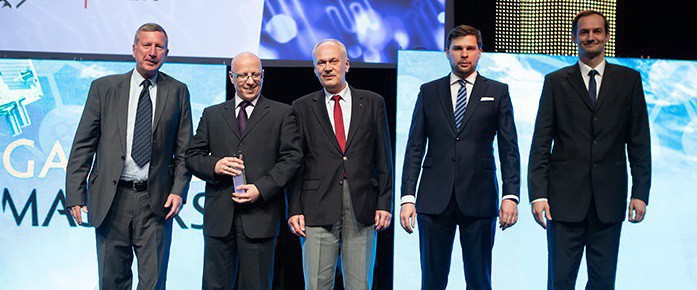The European GNSS Agency (GSA) had an important message for the recent 2019 Mobile World Congress in Barcelona: When close isn’t enough, use Galileo! The EU-funded NaviSoC project is doing just that, leveraging Galileo’s dual-frequency GNSS signal to create a unique, high-precision receiver for mass market applications.
Much has been made of the potential of GNSS to enable new location-based services (LBS) that will profoundly change the lives of mass-market users and businesses. The NaviSoC navigation chip is a very small, multi-frequency GNSS receiver capable of combining Galileo, EGNOS, GPS, GLONASS, BeiDou, and QZSS signals to bring precision positioning to a wide range of devices.
The NaviSoC chip is fully integrated and offers unlimited access to raw GNSS data on any level. It can also be used in combination with an external inertial measurement unit (IMU) to complement its positioning, navigation and timing (PNT) function.
“Our NaviSoC GNSS receiver is a semiconductor component meant to be integrated within bigger electronic equipment” said Tomasz Borejko, CEO of Polish company ChipCraft. “It is quite small, at 9mm by 9mm. So if somebody wants to integrate precise navigation in a smartwatch, they can put this chipset inside and they get a very precise position that they can display on a map, for instance.”
Galileo first
Borejko’s partner is Tomasz Radomski, owner of the INOWATRONIKA company, also based in Poland. Together, the two have created NaviSoC with support from the EU and the Polish government. “We are one of the first in the world to bring out a dual-frequency receiver,” Radomski said. “This captures L1/L5 and E1/E5 bands on GPS and Galileo, along with the signals from all other major GNSS constellations.”
“This is one of the main differentiators for our chip,” said Borejko. “We are using Galileo signals on both frequencies, and that means Galileo is the primary constellation for this chip. Second, we add GPS and then Russian GLONASS and Chinese Beidou. But the chip starts with Galileo as the primary constellation.”
“Galileo is our core,” said Radomski. “Thanks to this, using our chip, you have better accuracy, below one meter, even down to 10cm, and you have a more robust and reliable position.”
Some further details are worth noting; NaviSoC comprises a miniature GNSS receiver equipped with a multi-core 32-bit microcontroller (MPU), and it comes with a software development kit (SDK) that simplifies user application development.
“This feature really separates NaviSoC from other small GNSS receivers, and this can be very interesting for Internet of Things (IoT) applications and even for use in autonomous systems,” Radomski said. The NaviSoC team assures us that, to date, no product of this kind has been brought to market. So this chipset offers manufacturers right now the chance to incorporate a genuine high-accuracy GNSS receiver into small, mass-market devices for navigation and positioning.
Ready for action
“We are the second company, after Broadcom, to bring a dual-frequency GNSS chip to market,” said Radomski. “Of course we know that competition is coming, there will be more companies offering dual-frequency, but we are ready and eager to compete with them, with our accuracy and with the lowest price.”
Radomski said the NaviSoC team is now actively looking for customers. “We are in talks with several potential partners right now who want to use our chip. Some are interested in using it to create a module. Others are makers of end devices, end equipment. We are willing to sell to all customers who want our chips, from small companies who might need hundreds or a few thousand chips to bigger companies where we could be talking about millions.”
“This kind of product until now has been unachievable on the market,” said Borejko. “NaviSoC can be a market enabler for a future GNSS user segment, capable of bringing reliable, high-precision to mass-market users and applications, and taking the automation and autonomy of IoT devices to the next level.”
Galileo Masters winner
Obviously, someone agrees. NaviSoC won the 2018 Galileo Masters – Poland Edition Award, presented last year in Marseille, in conjunction with the EU Space Week Conference. Borejko said that event went a long way towards stimulating even more interest in the new chipset: “We met many interesting people from the satellite navigation industry in Marseille, with whom we hope to maintain contacts and establish cooperation.”
One person who has been following their progress closely is GSA Head of Market Development Fiammetta Diani. In the run-up to the Barcelona event, where the GSA shared a stand with NaviSoC and other EU-funded projects, Diani said: “According to the latest figures, today over 600 million devices – most of them the latest smartphone models – are now Galileo-enabled. Clearly, the time has come to make people aware that Europe’s investment in Galileo is bringing daily benefits to hundreds of millions!” NaviSoC is one such investment that appears to be poised to pay off in a big way.




